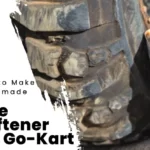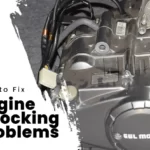Go-kart racing has grown immensely in popularity, becoming an adrenaline-pumping recreational activity and fiercely competitive motorsport. For racers looking to gain an edge, tire grip plays a pivotal role in achieving optimal performance.
This article provides a comprehensive overview of tire grip in go-kart racing, discussing tire selection, maintenance, setup, track-specific tactics, and in-depth coverage of tire wear, temperature, suspension setup, and aerodynamics.
| Key Takeaways |
|---|
| Tire grip factors, such as tire compound, pressure, track surface, tire wear, and temperature, all contribute to overall grip and kart performance; understanding these factors allows racers to make informed choices and adjustments. |
| Proper tire selection based on weather, track characteristics, driver preferences, and tire compounds, combined with regular maintenance, is essential for maximizing tire grip and overall go-kart racing performance. |
| Fine-tuning kart setup, including adjustments to wheelbase length, seat position, axle stiffness, and suspension components (camber, caster, and toe), directly affects tire grip, stability, and overall performance, leading to better race results. |
| Effective tire temperature management, involving tire warmers, pressure monitoring, and driving style adjustments, is crucial for maintaining optimal grip levels, prolonging tire life, and enhancing overall kart performance on the track. |
| Utilizing aerodynamic elements, such as bodywork and downforce components, and employing track-specific driving tactics can significantly improve tire grip, resulting in more competitive lap times and better handling in various racing conditions. |
Related Article: The Ultimate Guide to Go-Kart Tires
Understanding Tire Grip Factors
Tire grip is influenced by several factors, including:
- Tire compound: The balance between soft and hard compounds affects grip and tire life
- Tire pressure: Adjusting pressures to maximize contact patch area based on track conditions and temperatures
- Track surface: Different surfaces require tailored tire selections and driving styles
- Tire wear: Monitoring and managing wear to maintain consistent grip and performance
- Tire temperature: Managing tire temperatures to ensure optimal traction throughout a race
Tire Selection and Maintenance
Choosing the right tires and ensuring their proper upkeep is critical for maximizing tire grip and overall performance in go-kart racing. When selecting tires, consider the following factors:
- Weather conditions: Wet or dry conditions demand different tire compounds and treads to maintain optimal grip. For example, slick tires provide maximum contact on dry surfaces, while treaded or rain tires disperse water and maintain traction in wet conditions.
- Track characteristics: Different tracks, such as asphalt, concrete, or dirt, require specific tire compounds and tread patterns to ensure proper grip levels.
- Driver preferences: Individual driving styles and preferences, like aggressive or conservative racing, influence tire selection, as some drivers may prioritize grip over longevity or vice versa.
- Tire compounds: Soft, medium, and hard compounds offer varying levels of grip and wear. Soft tires provide a better grip but wear faster, while hard tires have a longer life but a reduced grip. Balancing these factors based on track conditions, temperature, and race duration is essential.
To maintain optimal tire performance, follow these maintenance tips:
- Tire rotation: Regularly rotating tires between different kart positions helps ensure even wear and prolongs tire life. This practice helps distribute the load and wear more evenly, as different kart positions experience varying stress levels.
- Wheel balancing: Unbalanced wheels can cause uneven tire wear and reduced grip. Periodically check for imbalances and address them by adjusting weights on the wheel rims.
- Alignment adjustments: Proper wheel alignment is crucial for maintaining even tire wear and optimal grip. Adjusting camber, caster, and toe angles can enhance tire contact with the track surface, ensuring maximum traction.
- Tire pressure management: Continuously monitor tire pressure and adjust it according to track conditions, ambient temperatures, and race duration. Tire pressure affects the contact patch and, subsequently, grip levels. Overinflated tires can reduce grip, while underinflated tires can cause overheating and uneven wear.
- Tire inspection: Regularly inspect tires for visible signs of damage, such as cuts, punctures, or excessive wear. Early detection and repair or replacement of damaged tires can prevent catastrophic failures and maintain optimal grip levels.
By carefully selecting the right tires based on various factors and ensuring proper maintenance, racers can maximize tire grip and enhance their go-kart performance on the track.
Kart Setup and Suspension Adjustments
Optimizing the chassis configuration, weight distribution, and suspension setup enhances tire grip and overall kart performance. An adequately set up kart allows for better tire contact with the track surface, improving traction and stability. Key factors to consider when optimizing your kart setup include:
- Wheelbase length: The distance between the front and rear axles affects kart handling and stability. A longer wheelbase typically offers better stability in high-speed corners but may compromise maneuverability in tight turns. Conversely, a shorter wheelbase can improve responsiveness and cornering agility but might be less stable at high speeds. Experiment with various wheelbase lengths to find the best balance for your specific kart and racing conditions.
- Seat position: The position of the driver’s seat directly impacts the kart’s weight distribution and handling characteristics. Adjusting the seat’s fore-aft position can help balance front and rear grip levels. Moving the seat forward can increase the front-end grip while moving it backward can provide more rear grip.
- Axle stiffness: The stiffness of the rear axle can alter how the kart transfers weight during cornering, influencing tire grip levels. Softer axles allow for more chassis flex, improving rear grip in low-speed corners, while stiffer axles provide better high-speed stability but might reduce low-speed grip. Testing various axle stiffness levels will help determine the ideal setup for your kart and driving style.
- Suspension adjustments: Although many go-karts feature a rigid chassis without traditional suspension components, some racing karts include adjustable suspension elements that can be fine-tuned to optimize tire grip and handling. Key suspension adjustments include:
- Camber: The inward or outward tilt of the wheels affects the tire contact patch with the track surface. Negative camber (top of the wheel tilted inward) can improve grip in corners, while positive camber (top tilted outward) can improve straight-line stability. Adjust camber settings based on track conditions and handling requirements.
- Caster: The angle of the steering pivot axis affects how the kart steers and transfers weight during cornering. The increasing caster can improve high-speed stability and cornering grip but might make steering heavier. Conversely, reducing the caster can make steering lighter but may compromise high-speed stability. Experiment with various caster settings to find the optimal balance for your kart and racing conditions.
- Toe: The angle at which the front wheels point about each other affects handling and tire wear. Toe-in (wheels pointing toward each other) can provide more straight-line stability, while toe-out (pointing away) can improve turn-in responsiveness. Adjust the toe settings to find the best balance between stability and cornering agility while minimizing tire wear.
By considering these factors and making adjustments as needed, racers can optimize their go-kart’s chassis configuration, weight distribution, and suspension setup to enhance the grip, stability, and overall performance on the track.
Related Article: How to Align Go-Kart Wheels: A Comprehensive Guide
Tire Temperature Management
Tire temperature management is crucial in go-kart racing, impacting tire grip and overall performance. Different tire compounds perform optimally within specific temperature ranges, making it essential to ensure tires are operating at the right temperature.
Methods for managing tire temperatures include using tire warmers to preheat the tires before a race, providing maximum grip from the start, and monitoring tire pressures, as they increase with temperature and can affect grip and wear.
Additionally, adjusting driving style can help manage tire temperatures. Avoiding excessive sliding, minimizing wheel spin, and braking smoothly can keep tires in their optimal temperature range. By effectively managing tire temperatures through these methods, drivers can maximize grip, prolong tire life, and optimize their kart’s overall performance on the track.
Aerodynamics and Tire Grip

Aerodynamics is another essential aspect in maximizing tire grip and go-kart performance. When properly optimized, aerodynamic forces, such as downforce, can enhance traction during high-speed cornering by increasing the tire pressure, leading to better grip. Optimizing kart aerodynamics often involves adjusting the bodywork, airflow, and aerodynamic components such as spoilers or wings.
By fine-tuning these elements, drivers can achieve a balance between increased downforce for improved cornering grip and reduced drag for higher top speeds. Understanding the role of aerodynamics and making the necessary adjustments can significantly enhance tire grip and overall performance, contributing to more competitive lap times and better handling in various racing conditions.
Track-Specific Tactics
Employing tailored tactics based on specific track characteristics can help racers optimize their go-kart performance. Key track-specific tactics include:
- Adapting driving styles to various corner types
- Hairpin turns at Slow entry speed with quick acceleration out of turn.
- Sweeping bends: Maintain steady throttle input for smooth steering
- Chicanes: Brake early and use precise steering to navigate tight corners
Related Article: What to Do With Used Go-Kart Tires
Conclusion
Mastering tire grip in go-kart racing requires understanding various factors influencing tire performance and adapting kart setup and driving tactics accordingly. By exploring tire wear, temperature management, suspension setup, and aerodynamics, racers can better understand tire grip and optimize their performance on the track.
Ultimately, a deeper knowledge of tire grip and its associated factors leads to improved race results and enriches the overall experience of go-kart racing, enabling drivers to fine-tune their skills and excel in this thrilling motorsport.

Goran, an experienced go-kart racer, fuels GoKartLife.com with his passion and expertise. He offers valuable insights and tips for fellow enthusiasts, fostering the growth of the go-kart community. Join Goran at GoKartLife.com and immerse yourself in this exhilarating sport.
Last modified: December 12, 2024



